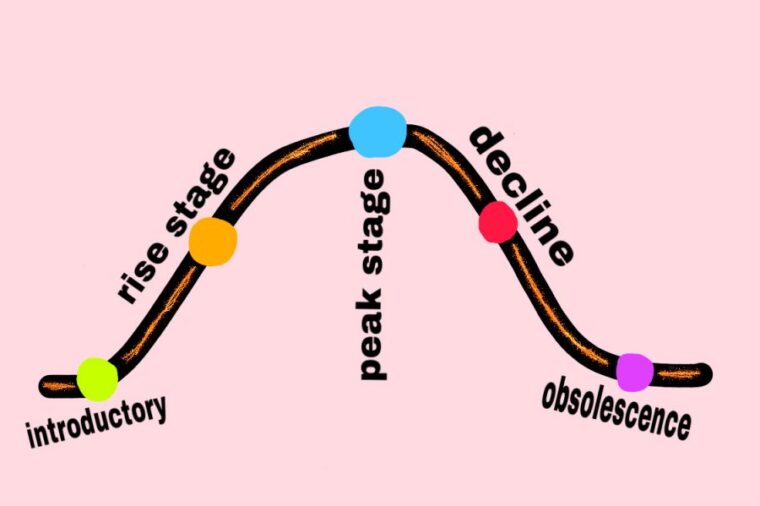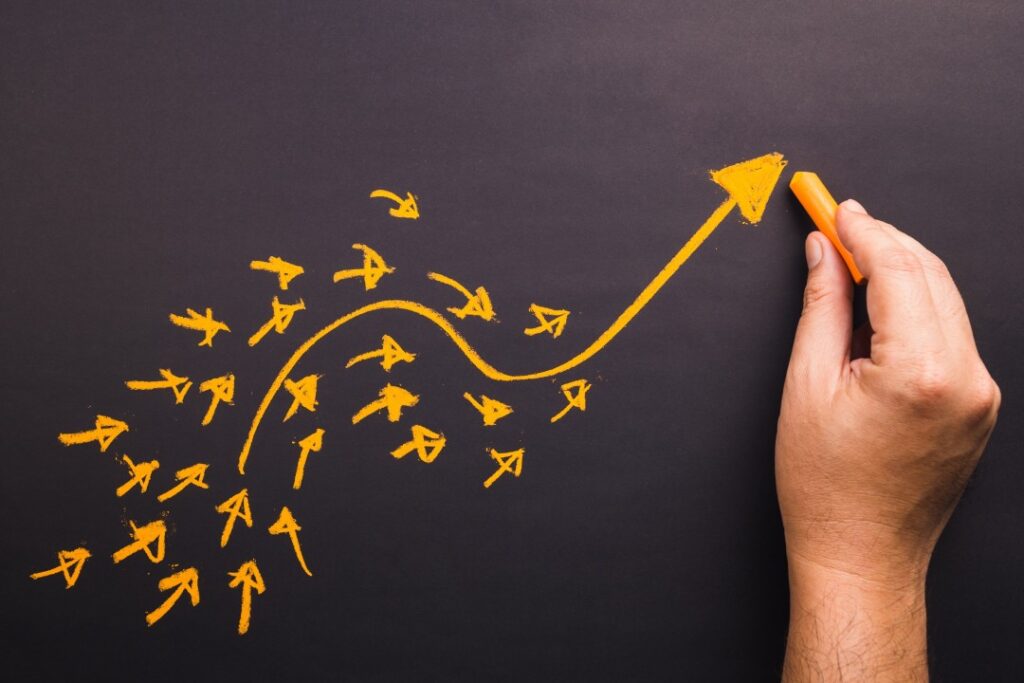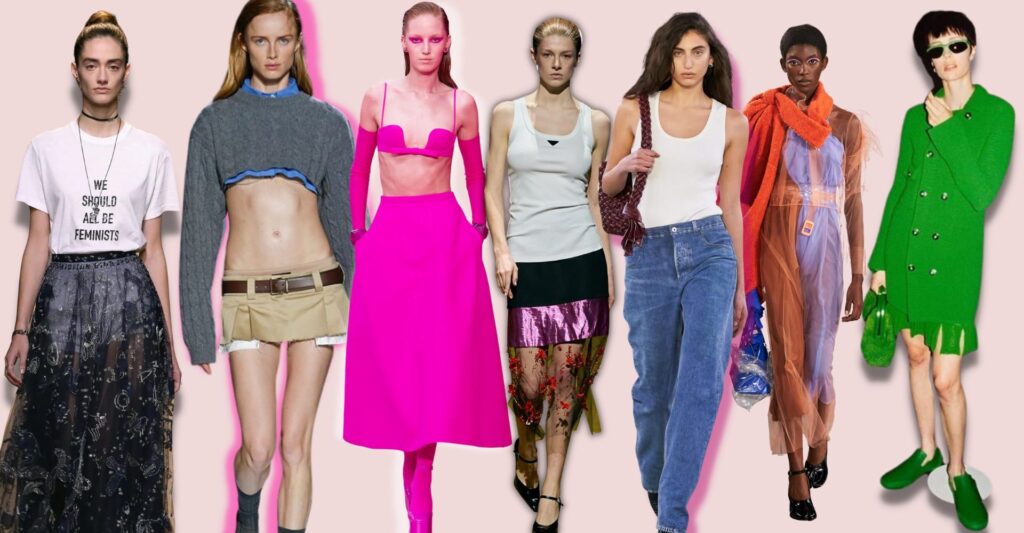Welcome back to my inquiry project! Building off of what I wrote in my last research round, for this research round I will be going more in-depth into the actual trends that rise and fall in our current society. First I will be looking at the life cycle and the idea behind trends and then applying them to real-life examples we see today. This is crucial to research for my inquiry question as it allows readers to understand the force and life cycle behind a trend and how it may resurrect at different times.

What is the life cycle of a trend?
Though this is specifically referring to a fashion trend, these steps can be applied to anything within context, the steps include; introduction, rise, peak, decline, and obsolescence (1).
Firstly for the trend to become what we know today, it has to be introduced to society first. Though we like to think this happens organically, most of the time it is the bidding of some sort of conglomerate as a means to further their own agenda. However, trends can also be an influence of anything that holds value and substance in our society. Whether that’s art, politics, or social movements, trends can surge up from anywhere (2). Something important to understand about the start of a trend though is that no matter what its influenced by, it is a result and the reflection of some sort of change within that topic or culture (3).
Secondly, once a trend has been introduced to society, it must rise toward the peak of its popularity. In today’s culture the process of entering this trend is usually endorsed by some sort of popular celebrity figure so that the ‘rising’ aspect happens for sure (1). This process is usually categorized when a trend that is introduced goes from ‘new’ to ‘trendy’. This is also the time when said trend will start to become accessible to more than just celebrities as well as everyday people (4).

Thirdly, the next step in the life cycle of the trend is known as the ‘peak’. This is where the trend will hit its highest point in popularity and is arguably the most profitable for those who gain from a trend. Furthermore, this is when the trend is most accessible to everyone including all consumer types. Additionally, this is when a trend will also become more saturated to fit the craze as well as be affordable for most individuals. Though some may say the peak is the shortest time frame in a trends life time, it is hard to predict anymore due to the versatility in the range of trends and the rate by which other trends rise and fall (1).
The life cycle of a trend can be compared to the outline of a mountain. Much like how there is a peak and the ‘top’ of a trend, all good things must come to an end, and the fourth step of the life cycle is referred to as the ‘decline’ (1). This is also when the glamour of a trend starts to wear off, and although the trend is still pretty popular to those who can finally join, it still begins to decline and make viewers move on to the next new trend (5).
The last and final step in the life cycle of a fashion trend is the obsolescence stage. Obsolescence is defined as the process of becoming obsolete which in simple words is when something isn’t in use anymore. It is important to know that there are multiple trends happening at the same time and that they start at midly different times, hence when one gets bored of a trend they may leave it for another trend that is at its peak as opposed to one that is declining and ‘out of fashion’ (1).
Real life example:

Though I have been talking about fashion trends for most of the references, an example of a trend that has gone through the 5 stages that had been talked about is the trend of working from home. Working from home was first introduced as a solution for millions who had to recouperate when the pandemic took over the world. Hence its introduction was one sanctioned by the government and large companies, as well as a change caused by the world. Secondly we can see the ‘rise’ factor, as more individuals began getting comfortable with the new working remotely system and companies began altering and creating new applications to cater to this new trend. Furthermore in the third stage, the ‘peak’ of this trend, almost all workers had moved on to remote work and the new trend had almost became a new status quo. In the declining stages of this trend, working from home began to decline as society began moving back into its ‘old’ way of working. Though the fifth and last stage of its life cycle would be the obsolescence would be the trend completely fading away, it would be ignorant to say the trend of working from home has completely gone away. Instead, in this specific case, working from home has declined significantly but also become part of our new status quo. In our new world we have instead a hybrid where one can choose from working at home or working in an office or even both. Hence, working from home is one of the best trends that clearly shows the progression of how a change in society can cause a trend and then become a new status quo (6).

By understanding the main stages of a trend, one is able to depict the application of this life cycle within their lives. Whether you notice the new fast fashion trend of the week and its life cycle within a couple of days, or even realize instances of the 5 stages throughout your life, it is important to be able to understand what drives trends as they are starting to become the force of progression within our society. By exploring this topic in this blog post I hope to have build off of the factors that drives trends and have given you the information needed for that trend to actually survive!
Thanks for reading!
Sanam M.
Sources:
1. Mollard, M. (2023, December 27). Understanding fashion trend life cycles: The 5 stages. Heuritech. https://www.heuritech.com/articles/five-stages-of-fashion-trend-life-cycle/#:~:text=A%20fashion%20trend’s%20life%20cycle,peak%2C%20decline%2C%20and%20obsolescence.
2. Understanding how trends are born: A look into the world of marketing and design. (2023, March 3). https://lsdmlondon.com/marketing/understanding-how-trends-are-born-a-look-into-the-world-of-marketing-and-design/#:~:text=It%20can%20be%20influenced%20by,the%20emergence%20of%20a%20trend.
3. How trends develop and how to track them? (n.d.). Spring Fair 2024. https://www.springfair.com/news/how-trends-develop-and-how-to-track-them#:~:text=How%20do%20trends%20develop%3F,home%20look%20and%20feel%20like%3F
4. Justice, B. (2024, March 29). The rise and fall of trends: Understanding the fashion trend cycle. UVU REVIEW. https://www.uvureview.com/valley-life/the-rise-and-fall-of-trends-understanding-the-fashion-trend-cycle/#:~:text=Following%20the%20introduction%20is%20a,replicated%20by%20other%20clothing%20brands.
5. Crane, K. (2023, September 25). The life cycle of a trend. Design Pool. https://www.designpoolpatterns.com/the-life-cycle-of-a-trend/
6. Silver, H. (2023). Working from Home: Before and After the Pandemic. Contexts, 22(1), 66–70. https://doi.org/10.1177/15365042221142839


Hi Sanam,
Great Blog Post, your Inquiry question caught my eye as it is something I have also realized, as a society, we tend to go through trends really fast. I really enjoyed reading it and liked how you mentioned how a trend goes through 5 stages of a trend, and how they usually end in obsolescence. I also like how you metioned how sometimes the wolrd’s situation can impact how trends come and go, such as lockdown, working from home, and then hybird working. I would have loved to see an example of how clothing trends change, as that is something which I feel can sometimes contradict the cycle of trends, since things typically come back in style. A question I have is, How does the life cycle of trends, including introduction, rise, peak, decline, and obsolescence, influence societal behaviors and practices?
Some sources that may be helpful in your future research are:
https://www.vice.com/en/article/bvmkm8/how-the-20-year-trend-cycle-collapsed
https://open.lib.umn.edu/communicatingfashion/chapter/chapter-6-trend-lifecycles-and-adopter-categories/
https://www.michigandaily.com/opinion/make-fashion-slow-again-how-social-media-sped-trends-up/
Overall great job and I look forward to reading your future Blog Posts!
Perla 🙂
Hello Sanam,
This is a very intriguing blog post! Keep up the good work! I have always noticed the old fashion trends coming back as I grew up, and my parents also mentioned to me a lot about how the fashion trends nowadays are the exact same as their ages… I also like how you talked about how learning about fashion trends can help one learn more about their life, and to notice other patterns in life. Here are some websites that might help you with your next blog post:
https://insights.klarna.com/fashion-trends/
https://www.vogue.com/fashion/trends
https://fashiontakesaction.com/articles/evolution-of-fashion-trends-from-the-1950s-to-present-day/
https://goodonyou.eco/micro-trends/